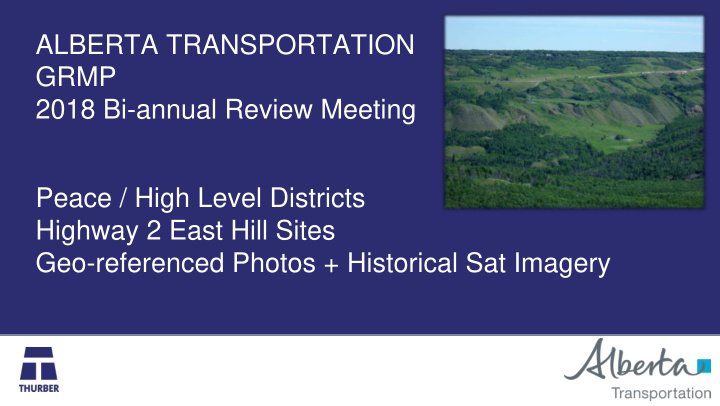



ALBERTA TRANSPORTATION GRMP 2018 Bi-annual Review Meeting Peace / High Level Districts Highway 2 East Hill Sites Geo-referenced Photos + Historical Sat Imagery
Peace River Region - Highway 2 - East Hill • Site area directly east of the Town of Peace River • Multiple sites within a 4 km segment of the Highway running along on the south- facing wall of the Heart River Valley. • Widespread and highly active mass wasting processes that include channelized erosion, earth flows, deep and shallow landslides within colluvium and glaciolacustrine sediments (Glacial Lake Matthews). 2
3
N HWY 2 Peace River Heart River v 4
CHALLENGES • Large site with many active, ongoing and interacting processes • Many of the geohazards do not directly impact the highway but could N lead to future instability or retrogressive processes that are cheaper / more practical to mitigate earlier (i.e. proactive approach) • Limited time on ground during annual inspections – important to establish what are the existing conditions, what has changed and setup consistent framework of comparison to make efficient use of time on site. • Large processes that can be difficult to interpret or understand broader site implications from the ground LiDAR and aerial imagery tools can help • Annual viewing of site (or limited instrumentation) – difficult to establish timeline or evaluate rate of geohazard processes 5
6
7
• GIS Workspace – all photo locations, waypoints, tracks, aerial imagery, marked terrain features, ect can be quickly compared with previous years (photo comparison still manual) 8
Photo Comparison 2009 2017 9
Photo Comparison 2009 2017 10
Photo Comparison 2016 2014 11
Photo Comparison 2009 2017 12
Historic Satellite 2002 Imagery 13
Historic Satellite 2002 Imagery 14
Historic Satellite 2012 Imagery 1 m LiDAR (2007) 15
Historic Satellite 2013 Imagery 16
Historic Satellite Imagery 2016 17
Photo Comparison 2009 2017 18
Historic Satellite Imagery 2013 2016 19
2016 20
Conclusions • Comparison methodology used in the development of the site plan with focus on areas that have observable rates of activity and/or future potential to cause instability or hazard to the highway • Combination of LiDAR and satellite/aerial imagery allows broader view of site processes • Historic imagery provides better context to the development process and rate of mass waste events • Helps create target areas for next year and guide the inspection process, esp. for future inspectors • Process could be refined with new technology and more frequent data gathering (e.g. drone survey) 21
Recommend
More recommend